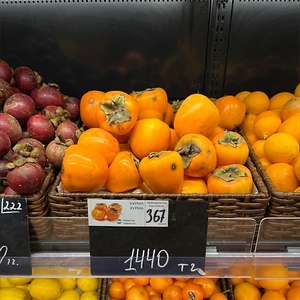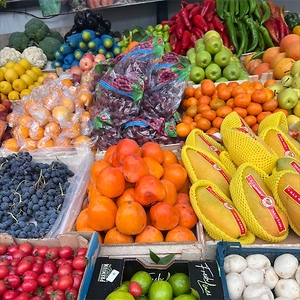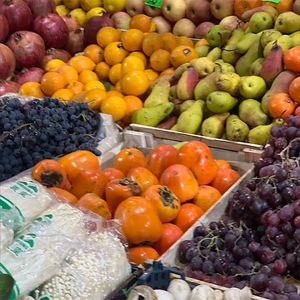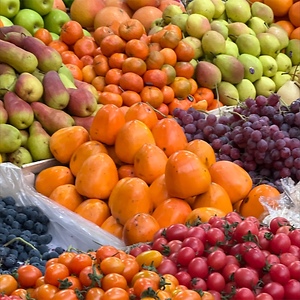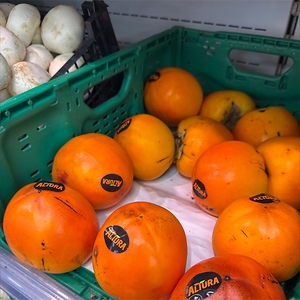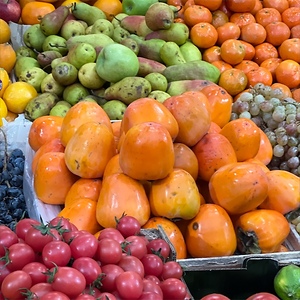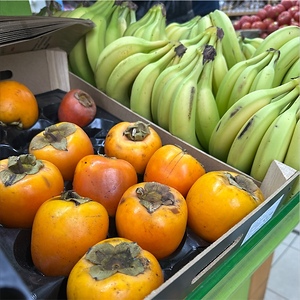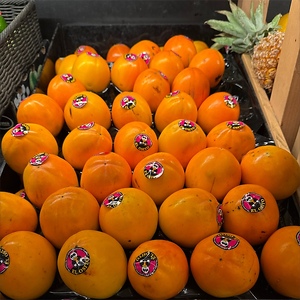


Hachiya Persimmons
Estimated Inventory, ea : 0
Description/Taste
Hachiya persimmons are small fruits that typically measure 7 to 10 centimeters in diameter and have a slightly tapered, oval shape. This variety features broad, curved shoulders that taper down to a small point at the non-stem end, similar to an acorn. Their skin is glossy, smooth, taut, and thin when young. It occasionally bears black sunspots and ripens to a yellow-orange, orange, or red-orange hue when mature. This skin becomes more translucent and wrinkled as the fruit ripens. Underneath the surface, Hachiya persimmons’ flesh is dense, firm, and golden orange when unripe. At this point, it has a high tannin content that creates an unpalatable, astringent flavor. As the fruit matures, the tannins break down, producing a gelatinous, aqueous, and soft texture with increased sweetness. Ripe Hachiya persimmons have a notably soft, delicate, and squishy feel, similar in consistency to a water balloon when squeezed. These ripe, nearly seedless fruits possess a sweet, honeyed flavor with subtle nuances of brown sugar, cinnamon, mango, apple, and apricot.
Seasons/Availability
Hachiya persimmons are available from fall to early winter.
Current Facts
Hachiya persimmons are botanically classified as Diospyros kaki and belong to the Ebenaceae family. They are frequently referred to as Oriental, Japanese, or Chinese persimmons. This variety is native to China and grows on deciduous trees that can reach up to 18 meters in height. Persimmons can either be astringent or non-astringent. The Hachiya variety is an astringent persimmon, meaning the flesh is deemed inedible until fully ripe. As the fruits mature, the flesh will soften, and the tannins will reduce, creating a jelly-like, juicy consistency with a sugary, honey-like taste. Hachiya persimmons are prevalent throughout Asian markets, and beyond culinary preparations, have been traditionally used for ornamental and medicinal purposes. Hachiya persimmons were once a niche fruit outside of Asia but have become one of the most popular seasonal persimmons grown in California.
Nutritional Value
Hachiya persimmons are high in vitamins A and C, nutrients that promote cell growth, immune support, collagen production, iron absorption, and eye, reproductive, heart, and skin health. They also help protect against free radical cell damage that can lead to chronic diseases. These fruits contain manganese that encourages metabolism and blood sugar regulation, wound healing, and bone health. Hachiya persimmons are also a source of fiber, supporting digestion, lower cholesterol levels, and appetite control. They provide the body with magnesium and lycopene to aid in energy production and muscle, insulin, and nerve function as well as help reduce inflammation, bad cholesterol levels, and UV ray damage. Hachiya persimmons have been used traditionally in China to treat stomach ailments, fever, and diarrhea. This fruit may also have antibiotic and anti-hemorrhagic properties.
Applications
Hachiya persimmons may be eaten fresh, dried, or preserved. They should be fully ripened before consumption, which may take anywhere from a few days to a few weeks, depending on the firmness of the flesh. Hachiya persimmons can be left to ripen on the counter at room temperature, and once soft and gelatinous, the flesh can be eaten fresh, spooned over oatmeal, yogurt, pancakes, and ice cream, or blended into sauces. The ripe fruits are popularly used in custards and puddings or incorporated into baked goods such as bread, cakes, pies, and muffins. In Japan, Hachiya persimmons are simmered into jams, compotes, and preserves, and whole fruits are frozen and eaten as a natural sorbet. They are also traditionally dried and consumed as a chewy snack or used as a sweetener in desserts, purées, and sauces. Hachiya persimmons pair well with nutmeg, cinnamon, allspice, ginger, maple syrup, vanilla, honey, nuts such as almonds, walnuts, and pistachios, and fruits like pomegranates, oranges, apples, and pears. Once ripe, Hachiya persimmons should be immediately consumed for the best quality and flavor. The fruits can also be stored in the refrigerator for an additional 1 to 2 days.
Ethnic/Cultural Info
In Japan, Hachiya persimmons are valued for their exceptional drying abilities, traditionally transformed into a delicacy known as hoshigaki. The name hoshigaki is a combination of hoshi, meaning dry, and kaki, meaning persimmon. Hoshigaki has been made for centuries as a method to preserve fruits during the cold winter months. The traditional drying process uses unripe Hachiya persimmons that are peeled, hung from a string, and left to dry for 4 to 6 weeks. As the fruits are drying, they must be hand massaged to soften the flesh, and over time, develop a soft, dense, sticky, and chewy consistency. Hoshigaki also produces a white bloom on the surface that's a natural coating of sugar, one of the traits that signals the dried fruits are ready for consumption. Hoshigaki is commonly sliced and consumed as a sweet snack or used to flavor wagashi, Japanese sweets served with green tea. The dried fruits are also used as decorations during New Year celebrations. Hoshigaki can be seen strung in windows, along covered porches, and in well-ventilated rooms as a symbol of longevity and good luck. Some Japanese families also gift hoshigaki to friends and family as a gesture of goodwill.
Geography/History
Hachiya persimmons are native to China. They flourish in moderate climates with subtropical to temperate conditions and high sun exposure. This variety has been cultivated for centuries and is frequently grown in orchards and home gardens, particularly in East Asia. Hachiya persimmons originated in China and spread to Korea and Japan between the 7th and 10th centuries. They were introduced to the United States through the USDA in 1870 and were planted in California, Georgia, and Florida. Today, Hachiya persimmons are widely grown throughout Asia in Japan, China, Korea, Myanmar, India, the Philippines, and Nepal where they are primarily sourced from local markets and grocers. Outside of Asia, these fruits are commonly cultivated in Mexico and California, especially in Tulare County, where they may be found at farmers' markets, specialty stores, and in home gardens where they are grown from trees.
Recipe Ideas
Recipes that include Hachiya Persimmons. One



